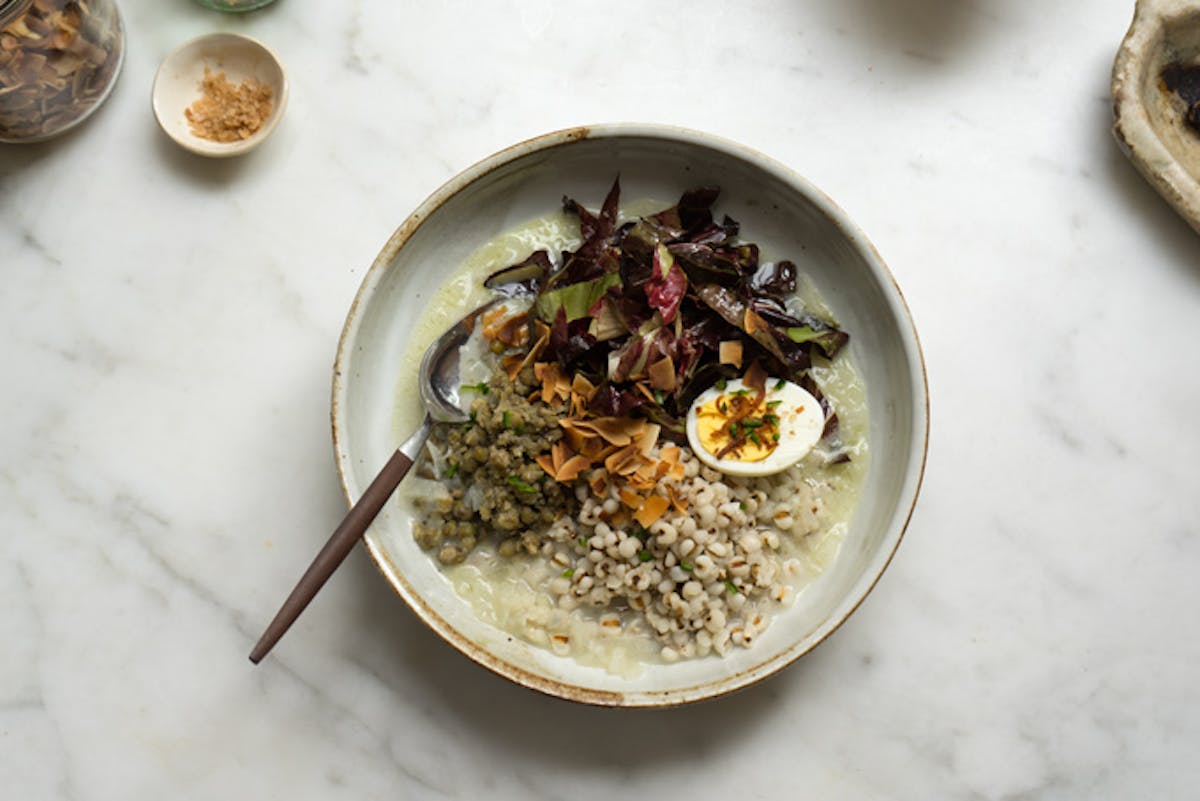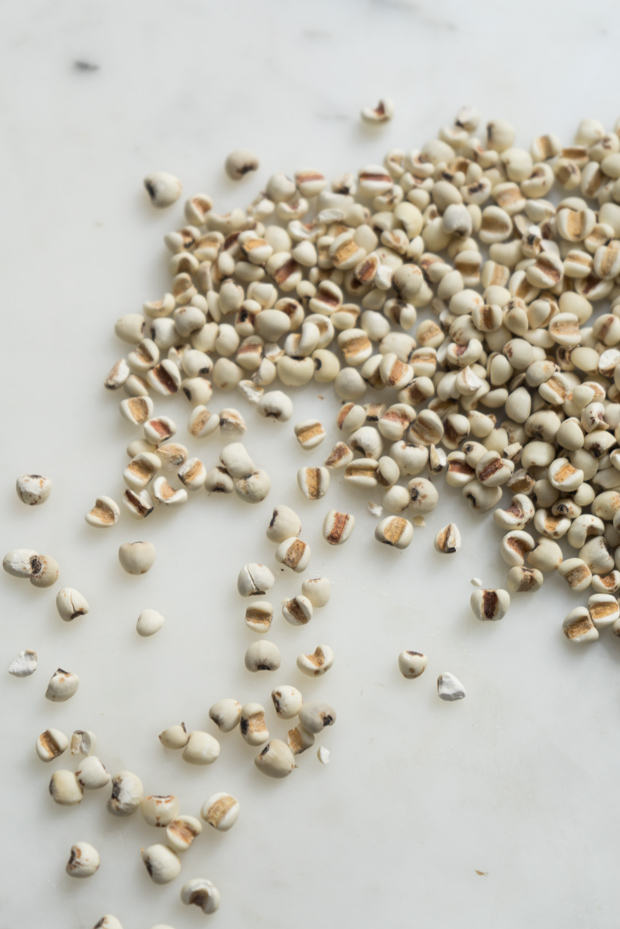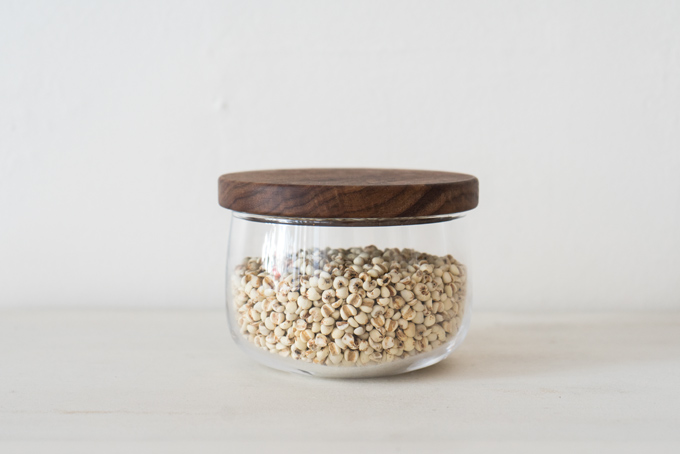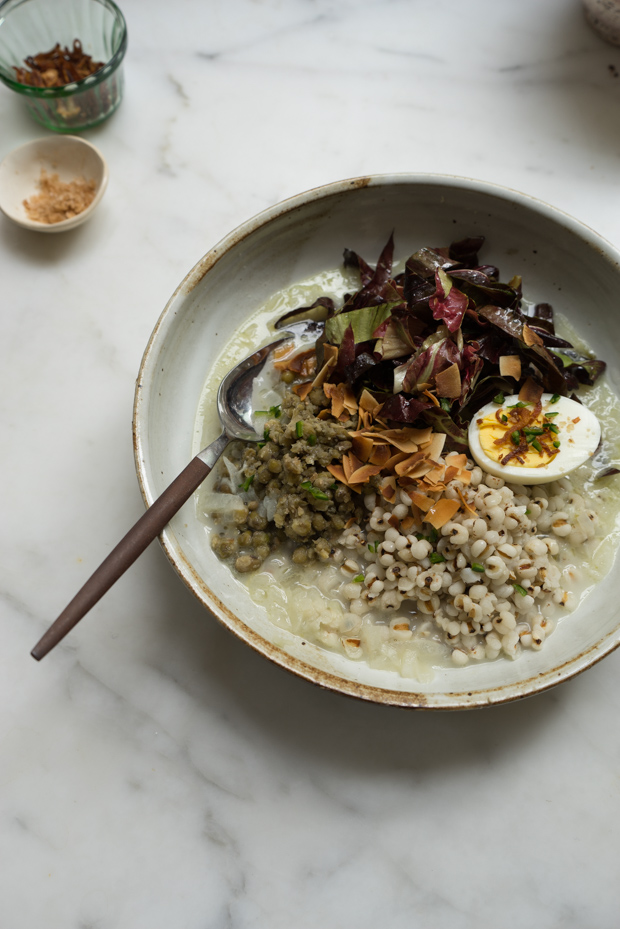Job’s Tears – You Need to Check Out this Power Ingredient Recipe
Job's Tears - you're missing out if you're not cooking with them. They're incredibly delicious, nutritious, and practically non-existent on the menus and tables I encounter. Here I share some of their perceived benefits, how I cook with them, and a Job's Tears in Coconut Broth recipe.

Job's tears are incredibly delicious, nutritious, and practically non-existent on the menus and tables I encounter. It perplexes me, because I love this ingredient. We're talking about an ancient heirloom pseudo-grain - it looks like a plump back tooth or molar. Technically, Job's tears come from a grass that produces these edible, ivory, bead-like seeds - pictured below. It is nutritionally significant, with a high protein to carbohydrate ratio, and is consumed in many cultures -- India, Japan, Korea, Burma, Thailand, the list is long -- to promote a wide range of benefits, and to support wellness in general. A notable exception, pregnant, and nursing women are often advised to avoid it, as are individuals on diabetes medications (because of its ability to lower blood sugar). Check with your medical professional if you're in either category. Job's tears are gluten-free, and although you might (also) see it labelled as Chinese barley, it is unrelated to barley. Check for gluten-free certification if you are concerned about cross-contamination with other grains containing gluten. I also see it around labelled hato mugi.
I'm still anticipating a few blank stares here, but I so love these unusual, versatile, and beneficial little weirdos, that I figure highlighting them might inspire you to welcome them to your repertoire if you haven't already. You can use Job's tears in an infinite number of ways, but here's how I did it last. My idea: make a thin, flavor-forward coconut broth which would envelop the Job's tears. Incorporate toasted coconut, spicy mustard oil, and the fresh curry leaves I had in the freezer. Here's how it worked.


After cooking a pot of Job's tears -- which, by the way, plump beautiful into chewy, substantial bites that have a texture that falls somewhere between pearled barley and pozole -- I set them aside. That's the most time intensive part of what becomes a perfect wintery-warming stew. From there, open a can of coconut milk, skim the cream from the top and use that as the cooking fat and base for a coconut broth. Give more dimension with a quick paste of shallots, garlic, serrano chile, and curry leaf, and increase the volume of the broth with the remainder of the coconut milk and some water. Add the cooked Job's tears to the pot once the broth comes to a simmer, then flare it out upom serving with extra texture and flavor when serving. It didn't occur to me until this very second that quick-pickled mustard greens with be the perfect topping, in addition to the other ideas listed in the recipe below, but there you have it. I save the broth from cooking the Job's tears, and make a tea with it, or use it as a component in preparations later in the week.

There is more information on Job's tears here, and a cool article about Job's tears used in baking flour here. As far as sourcing goes, you're most likely to find them in natural food stores, in the Asian section of some grocers, or do a search for organic Job's tears online. I'm hoping that if you happen to cook with them, perhaps you'll share your ideas and experiments in the comments here as well. That would be exciting for me. Keep scrolling for the full coconut broth recipe - it's down the page just a bit - enjoy! -h
Job's Tears in Coconut Broth
I sometimes make this stew using Job's tears, other times I'll do 1 1/2 cups cooked Job's tears plus 1 1/2 cups cooked mung beans for an added protein boost (as pictured above)...use whatever you have on hand. Skip the curry leaf if you don't have one, don't let that be a deterrent here. Also, you can use the broth from cooking the Job's tears in place of some of the water called for in the recipe if you like.
1 14-ounce can full-fat coconut broth
1 medium onion, chopped
3 medium shallots, chopped
2 small garlic cloves, peeled
1/2 serrano chile, de-stemmed and seeded
2 1/2 teaspoons fine grain sea salt
1 fresh curry leaf
5 cups water or broth
3 cups | 15 oz | 425 g cooked Job's tears*
3 cups | 4 oz | 115 g chicory lettuces, cut into 1 1/2-inch | 4cm pieces.Toasted coconut, chopped chives, spicy mustard seed oil, quick pickled mustard greens, and/or hard-boiled egg to serve.
To a large pot over medium heat, scoop the thick cream from the top of the can of coconut milk, this is going to be your cooking fat. Saute the onion until soft, five minutes or so. While that is happening, use a mortar and pestle to smash the shallots, garlic, chile, and salt into a paste. If you don't have a mortar and pestle use the flat side of a knife to carefully smash, and chop. Add this paste to the the onions, and saute for another few minutes. Add the curry leaf, the rest of the can of coconut milk, and the water, and bring to a simmer. Remove the curry leaf. Taste, and adjust the broth if needed. Stir in the Job's tears, and bring back to a simmer.
Toss the chicory with a small splash of olive oil, and a sprinkling of salt. Serve the stew, topped with a generous tangle of the chicory, and whatever other toppings you are planning to use. I've listed a number above but you might use as many or few as you like.
Serves 4.
*To cook Job's tears, soak them for twenty minutes (or up to a couple of hours), cover with water by a few inches, salt, and boil until they are tender. If I'm pressed for time, I'll skip the soak. After cooking, drain (reserving the broth for another use), and use the Job's tears in whatever preparations you like.
Prep time: 7 minutes - Cook time: 15 minutes





Post Your Comment
Comments
Just found these grains in a local Asian shop. Boiled then airfried with a little olive oil and salt. Delicious crunchy treats! Great for people with multiple food allergies
Love this!
Hi Heidi! Wondering how you might go about making Job’s tears in the instant pot! Or if stovetop is just better. Thanks!
Hi Mia – either will work. I add Job’s tears to my rice all the time, in both the IP and on stovetop….
I use it instead of corn to make hominy, grits ( from parboiled, dried and then grind in a spice grinder to make a meal- it’s gritty like cornmeal) then use to make polenta, grits, or porridge. I add it to spelt and millet for making flat bread. I cook some up in home made turkey stock because I need to develop a tasty flavor serve it with stewed collard greens and spicy curried goat. Can also be added to chewy Oatmeal cookies but only after cooking and draining them.
Love these ideas! Thanks Donna.
Job’s Tears or Adlai (called here in the Philippines as well) is becoming the new healthier substitute to rice or a more affordable alternative to Quinoa (it’s expensive here) I just cook it and stir fry it with favorite vegetables and eat is as an easy to prepare meal! Thanks for sharing this recipe. Must try it soon 🙂
well known by chinese and in chinese medicine spread to neighboring lands…
This dish is flavorful and delightful. And our one-year-old cannot get enough of it. (She also likes the plained cooked job’s tears and mung beans.)
I’d be interested in thickening this up like a congee. Any suggestions on how best to do that?
Once again, you have amazed me! I know Job’s Tears as the grass beads that my Grandma Grace used to make a divider curtain. I grew them because Momma liked the nostalgia of them, but I never knew they are edible! Must they be picked at a soft stage, or how are they harvested? I can’t imagine eating the mature, hard seed, but maybe they are no harder than corn. Thanks for the surprise!
My MIL makes a wonderful red bean soup using azuki, job’s tears, and other grains and seeds (that I have trouble identifying.) She sweetens it with Chinese rock sugar. It’s absolutely wonderful.
Hi Heidi! So excited to make this dish tonight. The one thing I couldn’t find is a fresh curry leaf. Where did you get it in SF? I checked BiRite, WF and Rainbow. I found dry leaves that are super small, would those work? And if so how many? Thank you!! 🙂
HS: Hi Jess! I sometimes find them at Rainbow or Bi-Rite – I think someone actually gave me the ones I used here. I keep them in the freezer. One goes a long way. And if you don’t have them, you can skip, or introduce another flavor…Hope this helps! Sorry it’s after dinner time 😐
Can’t wait to try this! I got some from MRH and they’re sitting there cause I didn’t know what to do with them. Thank you!
Job’s tears are served for breakfast in Thailand in soy milk, with red beans and soaked basil seeds. Here’s more info, from my fav Thai food blog! http://hot-thai-kitchen.com/soy-milk/
I read this on Thursday and knew that Job’s Tears was something I wanted to try. Found myself in NYC’s Chinatown on Friday and easily found some in the first store I tried (Chinatown Supermarket of Manhattan at 109 E. Broadway) and at $2.99 for 12 ounces I didn’t hesitate to buy them and I can’t wait to try them!
I love this ingredient, too. I wish I could find North American grown. I would recommend buying this at Japanese and Korean supermarkets rather than Chinese, because sulfur dioxide is usually added to the latter (it says so on the label) Savory versions sound lovely, but you must try it sweetened, too. I love iced mung bean and Job’s tears porridge in the summer. Make a pot of thin mung bean soup ( water + mung beans) and a smaller pot of Job’s tears. Add plenty of sugar, combine, and chill. Serve with ice cubes in the summer. It’s sooo good!
Job’s tears, never heard of it to be honest! I’m always up to try new healthy (and delicous! :D) things. I wonder what they’re called in Norway though… Thanks for the inspiration and I’ll come back if I find them in the store!
From previous comments it seems this pseudo grain has loads of health benefits! I’ve never seen it in France, have no idea where I could find it…too bad, your recipe sounds appetizing!
where to find in Adelaide..South Australia.. maybe an Indian grocer ??? will try the Health Food shop first???
I think I’ve had the Job’s Tears, but never known what they were exactly. Thanks for sharing the info, sure will try to cook and follow your recipe….
P/s: I think job’s tears is a beautiful name.
In Tamil (India) its called “Kattu Gundumani”, meaning pearl from the forest. This is a nutritious grain thats used in stews and medicines.. Your coconut broth recipe is a versatile & sounds delicious.. Your recipe looks fantastic and I’m definitely going to try it soon.. thanks for reminding us about this long-forgotten food..
Another stunning dish! I have never tried Job’s Tears before, but it did remind me visually of pearl barley which I looooove! This flavour combination sounds so exciting 😀 Thanks for sharing 🙂 x
Thanks for this inspiring take on using job’s tears. Job’s tears are very popular (and common) in Taiwan, where people mainly consume it for its health properties. Usually it is prepared as a “sweet soup,” either on its own or in combination with either mung beans (in summertime) or adzuki beans (in winter). Look forward to trying this savoury option.
Sold. I will be looking for these. I know I have seen them before but was ignorant about them and so never picked them up. But I love a good chewy grain.
The coconut broth sounds very nice.
Yes! I love Job’s tears. We use them in Chinese medicine as an herbal tea to strengthen digestion, clear heat in the body, and more. Soooo delicious. I love this coconut broth idea.
I worked at Tokyo Disney Sea for a few years and in the employee cafeteria they offered rice with the hato mugi as a healthier alternative to regular old white rice. I loved it! The chewy grains added a lovely texture to the rice. I never knew exactly what it was, though, so I’m glad to know!
Oh my goodness! I ate these about 20 years ago in Seoul. When I asked what are these, where do I buy them, the translator said that it was barley. I just always thought it must be an Asian hybrid. Thank you so much! Off to find some!
Hi. Thanks for this. Wondering where to find spicy mustard oil in the Bay Area?
My grandparents add a handful of job’s tears (mi ren in Chinese) to their homemade soymilk every morning. It makes the soymilk so much creamier and is incredibly nutritious, as you say. Thanks for sharing!
Ooh, I’ve never heard of or seen Job’s tears before, and from the name I would have guessed it would be an heirloom bean. I’ll have to keep my eyes peeled for them.
The chicory confuses me. I googled this and found roots, leaves and coffee. I am guessing that it is most likely the root that you are using, but am not sure. Can you please provide information about what you are using and the types of grocery stores where it can be purchased? I also would like to know where job’s tears could be purchased.
HS: Hi Kelsey – it just means little chicory lettuces (I’ll clarify in the recipe), alternately, you could massage a little shredded kale with the olive oil, and do that instead. Job’s tears can be found in some natural food stores, Asian grocers, or search online.
I, also, was introduced to Hato Mugi via Macrobiotics many years ago, and they have always been a staple in my pantry. They tend to be frightfully expensive. (Maybe that could change with increased popularity?) Hence, I tend to use them in condiment quantities. My standby uses have been in lentil soup (top off each cup of lentils with about a Tbs of the barley), or to add just a few Tablespoons to a pot of rice. In the rice, especially, it totally changes the dish into a toothsome, nutty foundation component.
I’ve used Job’s Tears before – but only as beads, never to eat! I did know that they were edible, but have never come across them that way. I did plant some a few years ago to grow for seed beads, as they grow with a blade of grass through them, that when dry pulls right out leaving a perfectly formed bead. I will have to try them like this next!
They sound so intriguing! I would love to know the story behind their anglicized name….. As someone who is fairly sensitive to grains and inflammation, I wonder if I could get away with eating these on account of them being grass (though rice and quinoa remain no gos…..)?
So interesting! I so want to try this stuff, thanks for spreading the word with such an inspiring post!
Koreans drink tea out of this grain. It’s creamy and delicious! The leaves and roots are used for medicinal purposes, too. But Korean traditional medicine advices pregnant women to eat/drink this grain in moderation.
my family is chinese american – i have never heard of the name job’s tears but it looks similar to what i grew up eating in soup. i also love the texture – i actually associate it with dessert! thanks for the new idea for using this ingredient!
I discovered this ingredients years ago, when I used to follow a macrobiotic diet, but I’ve never been able to try it – and I totally forgot. Now I’ll start to search it when I come in town! 😀
Can you find these locally in San Francisco? If so, where? Job’s tears sound amazing since I am both GF and corn-free. Thanks in advance!
HS: Hi Kate! – Rainbow always has them.
More Recipes
Weekly recipes and inspirations.
Popular Ingredients